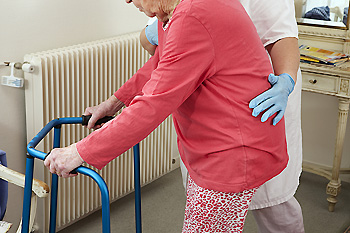Items filtered by date: June 2021
How Laser Treatment Works to Kill Toenail Fungus
 Fungal nail infections can be caused by many different types of fungi (yeasts or molds) that live in the environment. Small cracks in your nail or the surrounding skin can allow these germs to enter and cause an infection. Because nails get brittle with age, older adults are more prone to developing a fungal nail infection, as are those with a weakened immune system, circulation problems, diabetes, athlete’s foot, or who have recently experienced a nail injury or nail surgery. Laser therapy can often be effective in the treatment of this resilient fungal infection by targeting a laser light beam through the nail to kill the fungi without affecting the healthy parts of the nail and surrounding skin. If you have toenail fungus, contact a podiatrist to see if laser therapy treatment is right for you.
Fungal nail infections can be caused by many different types of fungi (yeasts or molds) that live in the environment. Small cracks in your nail or the surrounding skin can allow these germs to enter and cause an infection. Because nails get brittle with age, older adults are more prone to developing a fungal nail infection, as are those with a weakened immune system, circulation problems, diabetes, athlete’s foot, or who have recently experienced a nail injury or nail surgery. Laser therapy can often be effective in the treatment of this resilient fungal infection by targeting a laser light beam through the nail to kill the fungi without affecting the healthy parts of the nail and surrounding skin. If you have toenail fungus, contact a podiatrist to see if laser therapy treatment is right for you.
MLS Laser Therapy is a successful alternative for treating any pain you may be experiencing related to certain podiatric conditions. If you are interested in MLS Laser Therapy, consult with David Jenson, DPM, FAENS from Jenson Foot and Ankle Specialist. Our doctor will assess your condition and provide you with quality foot and ankle treatment.
MLS Laser Therapy
Multiwave Locked System (MLS) Laser Therapy is a patented, FDA-cleared technology that helps relieve pain and inflammation from a number of podiatric conditions, including:
- Heel Pain
- Plantar Fasciitis
- Sports Injuries
- Wounds
- Achilles Tendonitis
- Arthritis
- Neuropathy
- Neuromas
MLS Laser Therapy is an ideal alternative to surgery and prescription medication, as it has no negative side effects and encourages accelerated healing. Among its many clinical benefits, MLS Laser Therapy also:
- Reduces swelling due to bruising or inflammation
- Blocks pain
- Reduces formation of scar tissue
- Improves nerve function
If you have any questions, please feel free to contact our office located in The Woodlands, TX . We offer the newest diagnostic and treatment technologies for all your foot care needs.
Read more about MLS Laser TherapyDrinking Water May Help Cracked Heels
 The foot condition that is known as cracked heels can be unsightly and uncomfortable. It can occur as a result of standing on hard surfaces for the majority of the day, or wearing shoes that have an open back. Additionally, existing medical conditions including eczema and psoriasis may lead to developing cracked heels. It is beneficial to receive regular pedicures, and it may help to stay hydrated by frequently drinking water. There are patients who find mild relief when their feet are soaked in warm water, and it often helps to use a good moisturizer. If you have cracked heels and would like more information about how to prevent and treat them, please consult with a podiatrist.
The foot condition that is known as cracked heels can be unsightly and uncomfortable. It can occur as a result of standing on hard surfaces for the majority of the day, or wearing shoes that have an open back. Additionally, existing medical conditions including eczema and psoriasis may lead to developing cracked heels. It is beneficial to receive regular pedicures, and it may help to stay hydrated by frequently drinking water. There are patients who find mild relief when their feet are soaked in warm water, and it often helps to use a good moisturizer. If you have cracked heels and would like more information about how to prevent and treat them, please consult with a podiatrist.
If the skin on your feet starts to crack, you may want to see a podiatrist to find treatment. If you have any concerns, contact David Jenson, DPM, FAENS from Jenson Foot and Ankle Specialist. Our doctor can provide the care you need to keep you pain-free and on your feet.
Cracked Heels
It is important to moisturize your cracked heels in order to prevent pain, bleeding, and infection. The reason cracked heels form is because the skin on the foot is too dry to support the immense pressure placed on them. When the foot expands, the dry skin on the foot begins to split.
Ways to Help Heal Them
- Invest in a good foot cream
- Try Using Petroleum Jelly
- Ease up on Soaps
- Drink Plenty of Water
Ways to Prevent Cracked Heels
- Moisturize After Showering
- Skip a Shower
- Keep Shower Water Lukewarm
- Don’t Scrub Your Feet
If you are unsure how to proceed in treating cracked heels, seek guidance from a podiatrist. Your doctor will help you with any questions or information you may need.
If you have any questions, please feel free to contact our office located in The Woodlands, TX . We offer the newest diagnostic and treatment technologies for all your foot care needs.
Read more about Solutions for Cracked HeelsHow to Prevent Falling at Home
 Falls are a major cause of injury and disability among older adults. One of the most common places that seniors fall is in their own homes. This can be prevented by making several modifications to the living space. The easiest and fastest way to reduce risk of falling is to clear any clutter, especially from the floor and areas like hallways and staircases. Remove tripping hazards such as loose or slippery carpets or rugs. Install grab bars in the bathroom, where slippery floors can make falling more likely, and install handrails on the stairs. Install brighter lighting and nightlights to help seniors see where they are walking. Seniors with good foot health may be less likely to fall. To help maintain foot health and mobility, schedule an appointment with a podiatrist.
Falls are a major cause of injury and disability among older adults. One of the most common places that seniors fall is in their own homes. This can be prevented by making several modifications to the living space. The easiest and fastest way to reduce risk of falling is to clear any clutter, especially from the floor and areas like hallways and staircases. Remove tripping hazards such as loose or slippery carpets or rugs. Install grab bars in the bathroom, where slippery floors can make falling more likely, and install handrails on the stairs. Install brighter lighting and nightlights to help seniors see where they are walking. Seniors with good foot health may be less likely to fall. To help maintain foot health and mobility, schedule an appointment with a podiatrist.
Preventing falls among the elderly is very important. If you are older and have fallen or fear that you are prone to falling, consult with David Jenson, DPM, FAENS from Jenson Foot and Ankle Specialist. Our doctor will assess your condition and provide you with quality advice and care.
Every 11 seconds, an elderly American is being treated in an emergency room for a fall related injury. Falls are the leading cause of head and hip injuries for those 65 and older. Due to decreases in strength, balance, senses, and lack of awareness, elderly persons are very susceptible to falling. Thankfully, there are a number of things older persons can do to prevent falls.
How to Prevent Falls
Some effective methods that older persons can do to prevent falls include:
- Enrolling in strength and balance exercise program to increase balance and strength
- Periodically having your sight and hearing checked
- Discuss any medications you have with a doctor to see if it increases the risk of falling
- Clearing the house of falling hazards and installing devices like grab bars and railings
- Utilizing a walker or cane
- Wearing shoes that provide good support and cushioning
- Talking to family members about falling and increasing awareness
Falling can be a traumatic and embarrassing experience for elderly persons; this can make them less willing to leave the house, and less willing to talk to someone about their fears of falling. Doing such things, however, will increase the likelihood of tripping or losing one’s balance. Knowing the causes of falling and how to prevent them is the best way to mitigate the risk of serious injury.
If you have any questions, please feel free to contact our office located in The Woodlands, TX . We offer the newest diagnostic and treatment technologies for all your foot care needs.
Read more about Falls PreventionIt's Time for Beautiful Feet
A Relaxed Mind and Strong Body Can Reduce Running Injuries
With the long-term physical and emotional toll injuries can take on a runner, preparing the body and mind can go a long way in preventing injuries from occurring. Regular meditation can help you maintain a relaxed mind so you can stay present and focused on your movements. Breathing exercises can help you dissipate angry or agitated emotions so that you can remove stress and tension in your body to reduce your chances of injury. Strengthen your muscles and stamina gradually with preparation and proper training, and consider joining a running group for support and advice. You can also consult with a podiatrist who can recommend the best type of running shoe and also create custom orthotics that support your individual foot structure and running style. Both of these things can help further reduce your risk of injury.
Exercising your feet regularly with the proper foot wear is a great way to prevent injuries. If you have any concerns about your feet, contact David Jenson, DPM, FAENS of Jenson Foot and Ankle Specialist. Our doctor will treat your foot and ankle needs.
How to Prevent Running Injuries
Many common running injuries are caused by overuse and overtraining. When the back of the kneecap starts wearing out and starts causing pain in your knee, this is commonly referred to as runner’s knee. Runner’s knee is a decrease in strength in your quadriceps and can occur if you’re not wearing properly fitted or supporting shoes. To prevent runner’s knee, focusing on hip strengthening is a good idea, as well as strengthening your quads to keep the kneecaps aligned.
What Are Some Causes of Running Injuries?
- One cause of a common running injury is called iliotibial band syndrome.
- Plantar fasciitis is also another common injury.
- Stress fractures can occur from overtraining, lack of calcium, or even your running style.
Best Ways to Prevent Running Injuries
- Wear footwear that fits properly and suits your running needs.
- Running shoes are the only protective gear that runners have to safeguard them from injury.
- Make a training schedule. Adding strengthening exercises as well as regular stretching can help keep you strong and limber and can lessen the possibility of injuries.
- Stretching keeps muscles limber; this will help you gain better flexibility.
If you have any questions please feel free to contact our office located in The Woodlands, TX . We offer the newest diagnostic and treatment technologies for all your foot and ankle needs.
Read more about How to Prevent Running Injuries

